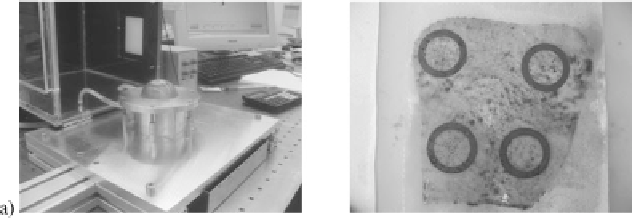Biomedical Engineering Reference
In-Depth Information
Fig. 26.5
(
a
) Inflation cylinder with cover ring bolted down with 6 screws. An inflated soft poly-
mer is visible. (
b
) Part of a liberated bovine liver capsule with the sandpaper rings attached
26.2.2.2 Inflation Tests
Inflation experiments allow to easily investigate the response of membranous tissue
to a biaxial loading. The circular sample is placed over a hollow cylinder filled with
saline solution and clamped using a rigid ring. Increased liquid pressure leads to
membrane inflation and the side view profile of the deforming sample is measured
with a video extensometer. The theoretical framework for data analysis is more in-
volved than that for the classic material tests such as uniaxial or in-plane biaxial
tests. In fact, the induced state of stress and strain is inhomogeneous, with equibi-
axial stress state at the center of the testpiece and a configuration of pure shear at
the clamping interface. For isotropic material behavior, the problem becomes truly
axisymmetric. The effective strain and stress fields must be computed using FE-
simulations postulating a particular constitutive behavior, or they must be estimated
from analytic approximations (Hollenstein,
2011
).
The setup is depicted in Fig.
26.5
. It consists of the inflation-cylinder, which is
connected by sidewise bores to an external pressure sensor and a peristaltic pump, a
mounting rail for the extensometer CCD-camera, an LCD-backlight to enhance the
image contrast, a control box that contained the peristaltic pump and all the elec-
tronic measuring equipment, and a control-PC. The inflation-cylinder was made of
aluminum with an inner diameter of 50 mm, an outer diameter of 60 mm. A cover
ring of 1 mm thickness with an inner diameter of 50 mm and an outer diameter
of 60 mm, and with a chamfer radius at its inner perimeter of 0.5 mm was used
to clamp the samples to the cylinder by dint of 6 screws. Physiological saline so-
lution was used to inflate the liver capsule samples to rupture at room temperature
without preconditioning. For the tests on the liver capsule, the final experimental
data included the pressure course inside the inflation cylinder and the displacement
history of the apex of the inflated specimen, i.e. the maximal vertical displacement
progression of the specimen. More details about the setup can be found in Egger
(
2008
) and Hollenstein (
2011
). Sandpaper rings were used to improve the effective-
ness of the clamping. They were prepared with inner and outer diameters of 50 mm
and 70 mm, respectively. A commercial cyanoacrylate based glue was applied on
the outer margin of the smooth surface of these precut sandpaper rings. The sandpa-
per rings with the glue were then gently applied onto capsule regions devoid of any








